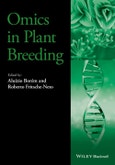Computational and high-throughput methods, such as genomics, proteomics, and transcriptomics, known collectively as “-omics,” have been used to study plant biology for well over a decade now. As these technologies mature, plant and crop scientists have started using these methods to improve crop varieties. Omics in Plant Breeding provides a timely introduction to key omicsbased methods and their application in plant breeding.
Omics in Plant Breeding is a practical and accessible overview of specific omics-based methods ranging from metabolomics to phenomics. Covering a single methodology within each chapter, this book provides thorough coverage that ensures a strong understanding of each methodology both in its application to, and improvement of, plant breeding.
Accessible to advanced students, researchers, and professionals, Omics in Plant Breeding will
be an essential entry point into this innovative and exciting field.
- A valuable overview of high-throughput, genomics-based technologies and their applications to plant breeding
- Each chapter explores a single methodology, allowing for detailed and thorough coverage
- Coverage ranges from well-established methodologies, such as genomics and proteomics, to emerging technologies, including phenomics and physionomics
Aluízio Borém is a Professor of Plant Breeding at the University of Viçosa in Brazil.
Roberto Fritsche-Neto is a Professor of Genetics and Plant Breeding at the University of São Paulo in Brazil.
Table of Contents
List of Contributors ixForeword xiii
1 Omics: Opening up the "Black Box" of the Phenotype 1
Roberto Fritsche-Neto and Aluizio Borem
The Post-Genomics Era 3
The Omics in Plant Breeding 4
Genomics, Precision Genomics, and RNA Interference 5
Transcriptomics and Proteomics 8
Metabolomics and Physiognomics 8
Phenomics 9
Bioinformatics 10
Prospects 10
References 10
2 Genomics 13
Antonio Costa de Oliveira, Luciano Carlos da Maia, Daniel da Rosa Farias, and Naciele Marini
The Rise of Genomics 13
DNA Sequencing 13
Development of Sequence-based Markers 18
Genome Wide Selection (GWS) 25
Structural and Comparative Genomics 27
References 28
3 Transcriptomics 33
Carolina Munari Rodrigues, Valeria S. Mafra, and Marcos Antonio Machado
Methods of Studying the Transcriptome 34
Applications of Transcriptomics Approaches for Crop Breeding 46
Conclusions and Future Prospects 51
Acknowledgements 51
References 51
4 Proteomics 59
Ilara Gabriela F. Budzinski, Thais Regiani, Monica T. Veneziano Labate, Simone Guidetti-Gonzalez, Danielle Izilda R. da Silva, Maria Juliana Calderan Rodrigues, Janaina de Santana Borges, Ivan Miletovic Mozol, and Carlos Alberto Labate
History 59
Different Methods for the Extraction of Total Proteins 60
Subcellular Proteomics 64
Post-Translational Modifications 66
Quantitative Proteomics 69
Perspectives 72
References 73
5 Metabolomics 81
Valdir Diola (in memoriam), Danilo de Menezes Daloso, and Werner Camargos Antunes
Introduction 81
Metabolomic and Biochemical Molecules 83
Technologies for Metabolomics 83
Metabolomic Database Analysis 86
Metabolomics Applications 89
Metabolomics-assisted Plant Breeding 91
Associative Genome Mapping and mQTL Profiles 95
Large-scale Phenotyping Using Metabolomics 97
Conclusion and Outlook 98
References 99
6 Physionomics 103
Frederico Almeida de Jesus, Agustin Zsogon, and Lazaro Eustaquio Pereira Peres
Introduction 103
Early Studies on Plant Physiology and the Discovery of Photosynthesis 104
Biochemical Approaches to Plant Physiology and the Discovery of Plant Hormones 104
Genetic Approaches to Plant Physiology and the Discovery of Hormone Signal Transduction Pathways 106
Alternative Genetic Models for Omics Approaches in Plant Physiology 112
"Physionomics" as an Integrator of Various Omics for Functional Studies and Plant Breeding 117
Acknowledgements 121
References 121
7 Phenomics 127
Roberto Fritsche-Neto, Aluizio Borem, and Joshua N. Cobb
Introduction 127
Examples of Large-scale Phenotyping 128
Important Aspects for Phenomics Implementation 134
Main Breeding Applications 141
Final Considerations 144
References 144
8 Electrophoresis, Chromatography, and Mass Spectrometry 147
Thais Regiani, Ilara Gabriela F. Budzinski, Simone Guidetti-Gonzalez, Monica T. Veneziano Labate, Fernando Cotinguiba, Felipe G. Marques, Fabricio E. Moraes, and Carlos Alberto Labate
Introduction 147
Two-dimensional Electrophoresis (2DE) 148
Chromatography 150
Mass Spectrometry 155
Data Analysis 161
References 164
9 Bioinformatics 167
J. Miguel Ortega and Fabricio R. Santos
Introduction 167
The "Omics" Megadata and Bioinformatics 167
Hardware for Modern Bioinformatics 169
Software for Genomic Sequencing 170
Software for Contig Assembling 172
Assembly Using the Graph Theory 173
New Approaches in Bioinformatics for DNA and RNA Sequencing 174
Databases, Identification of Homologous Sequences and Functional Annotation 175
Annotation of a Complete Genome 179
Computational System with Chained Tasks Manager (Workflow) 181
Applications for Studies in Plants 182
Final Considerations 183
References 184
10 Precision Genetic Engineering 187
Thiago J. Nakayama, Aluizio Borem, Lucimara Chiari, Hugo Bruno Correa Molinari, and Alexandre Lima Nepomuceno
Introduction 187
Zinc Finger Nucleases (ZFNs) 190
Transcription Activator-like Effector Nucleases (TALENs) 193
Meganucleases (LHEs: LAGLIDADG Homing Endonucleases) 194
Clustered Regularly Interspaced Short Palindromic Repeats (CRISPR) 195
Implications and Perspectives of the use of PGE in Plant Breeding 197
References 202
11 RNA Interference 207
Francisco J.L. Aragao, Abdulrazak B. Ibrahim, and Maria Laine P. Tinoco
Introduction 207
Discovery of RNAi 208
Mechanism of RNA Interference 209
Applications in Plant Breeding: Naturally Occurring Gene Silencing and Modification by Genetic Engineering 211
Resistance to Viruses 215
Host-induced Gene Silencing 218
Insect and Disease Control 218
Improving Nutritional Values 219
Secondary Metabolites 220
Perspectives 220
References 222
Index 229








